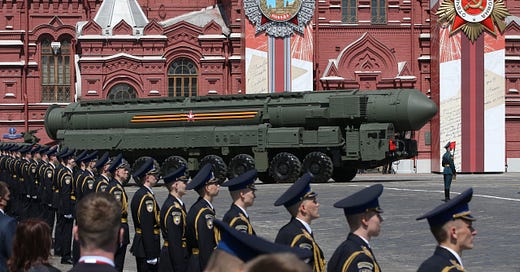
Is the United States Ready for the Next Nuclear Era?
Lessons from the Cold War can help the United States in nuclear competition with Russia and China.

[Editor's note: This article is based on testimony the authors delivered to the Senate Armed Services Committee Hearing on Nuclear Strategy and Policy on September 20.]
The United States faces the most complex configuration of questions about nuclear weapons since the onset of the nuclear age. The most important new factor is the potential that the United States will have to deal simultaneously with two near-peer nuclear powers. Unlike in the Cold War, in which the United States primarily focused on nuclear competition with the Soviet Union, today it faces trilateral nuclear competition with both Russia and China. This situation is unprecedented.
The Chinese nuclear arsenal is expanding rapidly. The commander of Strategic Command, Adm. Charles Richards, described the growth of China’s arsenal as “breathtaking” and former Vice Chairman of the Joint Chiefs of Staff Gen. John Hyten called it “unprecedented.” For many years, China was thought to maintain an arsenal of about 200 nuclear warheads. That estimate has since grown to about 350, and could expand to 1000 or more by 2030. As it acquires more warheads, the People’s Liberation Army is also developing a full nuclear triad much earlier than most observers anticipated, as well as capabilities that could call “strategic stability” into question. In addition to China’s first air-refuellable bomber and its first credible sea-based nuclear deterrent, the test last year of what seems to be a fractional orbital bombardments system raises the prospect of a short or no-warning attack—an extremely destabilizing development.
Russia, of course, remains today the only existential challenge to the United States because of the size of its nuclear arsenal. Russian nuclear forces have undergone major modernization in the past 15 years, and those efforts are continuing. Russia, of course, also maintains a large stockpile of theater nuclear weapons—perhaps 10 times the number of similar weapons in the U.S. inventory. In 2018, President Putin announced several exotic nuclear weapons including “a new heavy intercontinental ballistic missile (ICBM); a nuclear-armed hypersonic glide vehicle (HGV); a nuclear-armed, air-launched hypersonic missile; a nuclear-powered, nuclear-armed cruise missile; and a nuclear-powered, nuclear-armed submarine drone.” The precise purpose of these new weapons remains unclear and some of them seem to reflect the pursuit of capabilities which the U.S. considered too dangerous to develop. Nonetheless, they create additional uncertainty about “strategic stability” and must be addressed if there is to be any follow-on agreement to New START.
The role of new technologies like artificial intelligence, hypersonics, and cyber capabilities may complicate nuclear deterrence in ways we are only beginning to understand. Cyber intrusions into nuclear command and control systems, for instance, could undermine assumptions that underpin our concepts of nuclear deterrence like assured second-strike retaliatory capability. Such technologies, combined with fractional orbital bombardment systems or other maneuverable hypersonic weapons, could provide nations with a “decapitation” option that would force governments to adopting risky “launch on warning” postures, which magnify the possibility of human errors and mistakes.
As if the above challenges were not enough, American policymakers and strategists will have to contend with the prospect that China and Russia will maintain close collaboration and may even work toward an alliance. These kinds of question will require the kind of sustained intellectual effort that we undertook in the Cold War but largely abandoned after 1992.
American treaty allies still rely heavily on the U.S. nuclear guarantee—hence the universal opposition by our NATO and Asian allies to the Biden administration’s consideration of adopting a “no first use” police in its Nuclear Posture Review. Splitting the United States from its allies remains a clear objective of both Russia and China. As long as the U.S. hopes to maintain one of its most important comparative strategic advantages, its allies, in the long-term competition with Moscow and Beijing, it must still assure allies that we will defend them against conventional and nuclear aggression. The credible threat of nuclear retaliation against an aggressor will necessarily remain a part of the equation.
What is there to be done? First, we must proceed with modernization of all three legs of the nuclear triad—a necessity the Senate recognized when it made modernization a condition of its ratification of the New Start Treaty in 2010. The U.S. nuclear force must remain robust, redundant, survivable, responsive, controllable, visible, and capable of penetrating enemy defenses to hold their valued assets, including their forces, leadership, and their war-supporting industry at risk if it is to remain a credible deterrent. The ability to absorb a first strike and retaliate against an aggressor while also holding in reserve sufficient forces to deter the other near peer will likely, in the future, require larger numbers of deployed warheads than New START allows. This also means continuing to modernize our nuclear command, control and communications backbone to ensure its robustness against the threat of low or no-warning attack.
We must be sensitive to both strategic and theater nuclear capabilities. As Russia and China seek to stress and split America’s alliances, much as they did in the Cold War, we cannot allow them to make nuclear threats to deter U.S. counter-intervention in Europe or the Indo-Pacific without the means to answer in kind.
Nuclear deterrence today faces very real and novel challenges, but that does not mean we need to start from scratch. Much of what the Cold War taught us about deterrence remains valid. We cannot allow our adversaries to dictate to us because they hold a strategic or theater nuclear advantage. We must invest in deterrence—not only with our defense budget, but with the rhetoric of our most senior leaders and with the combined intellectual capacity of our defense establishment—because we cannot afford not to.









